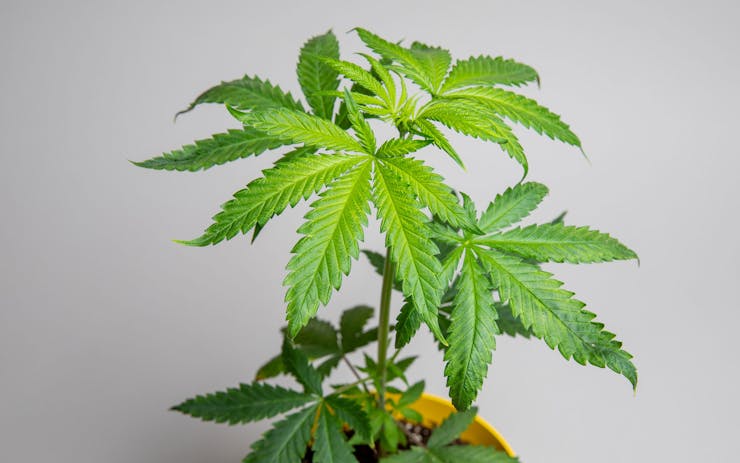This week marks the first anniversary of Canada’s recreational cannabis legalization. It’s an appropriate time to review what happened last year and consider what’s coming next.
Legalization brought big changes for some folks. About 9,200 employees now work at cannabis producers, with thousands more at retailers. Unfortunately, company profits remain scarce and tax revenues are modest.
By contrast, cannabis users are largely unchanged. In the nine months before legalization, an average of 14.9% of Canadians reported using cannabis. That increased by only one-tenth, to 16.3%, during the nine months after.
However, those users have increasingly bought their cannabis legally.
Sales grew
Health Canada data show July’s legal recreational and medical sales totalled 11,387 kilograms of dry cannabis and 9,854 litres of cannabis oil. That’s the fifth consecutive month of expanding sales.
Assuming the growth trend continued into August and September, legal products might now constitute 30% of Canada’s estimated consumption. Legal home growers likely supply a few percentage points more.
That’s a big improvement from September 2018, when legal sales represented only 8% of national demand. But illegal suppliers still control most of the market.
Producers and retailers expanded
The limited sales success was largely due to ongoing shortages of dry cannabis products throughout fall and winter. But supplies began improving in spring.
Alongside improving supplies came expanding retail networks. Canada had just over 100 licensed stores in October 2018, but now has more than 550.
Some of those have succeeded wildly. Quebec’s government-owned outlets each averaged $940,000 in monthly sales over the summer. Ontario’s private retailers likely did too.
But the high sales per store were largely due to having few stores per province. The store scarcity meant legal cannabis captured merely a fraction of each province’s market.
By contrast, Alberta and New Brunswick have far more retailers per capita, letting legal cannabis seize bigger market shares. But New Brunswick’s outlets averaged just $150,000 each in monthly sales, while Alberta’s shops did only slightly better.
So, low store density is good for retailer profitability but not for public policy.
From the latter perspective, Alberta’s retailing approach appears inspired. It had 65 stores open in November, more than any other province. It now has 301, more than all other provinces combined.
Conversely, Ontario’s approach increasingly seems misguided. Its initial 25-store limit was reasonable, given last December’s shortages of products and information. But its July decision to license only 50 more shops was far too timid, given how much supplies had improved.
Policies need review
In fact, this is a good time for all governments to revisit their cannabis strategies. But any resulting updates should reflect their newfound experience, not their ideological reflexes.
Consider Quebec’s good example. It recently announced plans to double its store count by spring, thereby improving access for its large population.
Ontario should follow that lead. As its Chamber of Commerce argued last month, the province needs more retailers and clear processes for adding them.
Meanwhile, New Brunswick is considering privatizing its money-losing cannabis retailer. But it might be better to follow Nova Scotia’s example and put its cannabis shops inside liquor stores. That would maintain accessibility while lowering operating costs.
Provinces should also rethink store ownership limits. To ensure competition, Alberta forbids any company from holding more than 15% of all retail licences. That’s about 45 shops, reasonable enough given the province’s size.
By contrast, Ontario limits chains to only 75 sites, too few for its large population. And British Columbia restricts them to eight, dooming retailers to inefficiency.
Provinces should review cannabis pricing too. Quebec charges retail prices just 28% above what it pays producers. That makes legal products competitive with illicit ones.
By contrast, price mark-ups apparently average 54% in New Brunswick, 74% in Ontario and 90% in Newfoundland. That generates more revenue but gives black markets big advantages.
This pricing issue will grow more important as Canada’s cannabis market evolves in the years ahead.
Coming competition
Until recently, the main limits on legal cannabis’ success have been shortages of products and stores. But with those improving, the new challenges will be to compete with black markets on price and quality.
That means legal prices must drop, at least for value-priced products. Other provinces should follow Quebec’s lead on that.
Meanwhile, producers must continuously improve their product quality to offer aromas, potencies, and effects comparable to the best illicit weed.
The arrival of cannabis foods, drinks, vapes, and lotions in late December should also help. They’re important because about a quarter of cannabis usage involves foods and vapes. Plus, those value-added products provide licensed producers with excellent opportunities to distinguish themselves from illegal suppliers.
Cannabis beverages will be particularly interesting to watch. Will they partly replace alcohol as a social beverage, as many producers hope? Or will they remain a niche product?
Of course, illegal suppliers will also be dropping their prices and improving their products. Consequently, the more legal sales grow, the tougher it will be to grow them further. And that dynamic could make legalization’s first year, despite all its stumbles, look like the easy part.
This article was originally published on The Conversation, an independent and nonprofit source of news, analysis and commentary from academic experts. Disclosure information is available on the original site.






